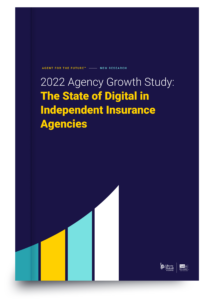Nearly six in 10 Americans have been victims of cyber or digital crime, according to the Norton 2022 Cyber Safety Insights Report.
It’s the most common type of crime someone can experience, and while a majority of Americans recognize the risks they face online—nearly 80% acknowledge they need more personal online protection, according to an Aura and The Harris Poll survey—few are taking action to protect their digital identity beyond changing their passwords.

Our new research report found that cyber liability is a top concern for agents. Click here to read more about how agents are using digital.
This disconnect has only grown more significant during the pandemic. As businesses turned to digital technology and the internet to stay afloat in the face of COVID restrictions, our personal lives were also increasingly pushed online.
At the same time, cybercriminals have gotten more sophisticated and are committing internet fraud at a much greater volume and scale. So, while cybersecurity is often considered a big business problem, it’s quickly becoming a concern for the average consumer.
As an industry, insurance has an opportunity to fill this need and offer products that better serve the full spectrum of personal cyber risk. As trusted advisors on the front line with clients, independent agents also have an opportunity to help educate customers on the importance of cyber insurance and guide them through the purchasing process.
There are four ways agents can easily and effectively make the case for personal cyber coverage.
Make it approachable
Cyber insurance is a complex market that can be confusing and intimidating for even the most tech-savvy customer. While most people understand that cybercrime is all around us, many aren’t aware of just how accessible cyber protection is through their insurance carrier.
A cyber endorsement on a home-owners policy will meet the needs of a vast majority of the market, at a price point that is attractive for most consumers.
Making cyber insurance approach-able is an important first step when advising clients on their cyber risk. Agents should aim to strike the balance of providing enough education about the importance of cyber insurance, the risks we face in our digital lives and the affordability of cyber products—without overwhelming the client.
Keep it straightforward, avoid using jargon and lean into facts and figures that speak to the prevalence of cyber risk in our day-to-day lives. Here are a few basic definitions of some of the most common types of cybercrime to use when educating clients, along with compelling stats that showcase the scale and scope of cyber risk:
- When bad actors use a fake email, website, text or phone call to trick you into giving up sensitive information. Nine in 10 Americans have faced a phishing scam in the last year, according to a survey by Incogni.
- Personal data breaches. When confidential personal information is stolen, destroyed or otherwise used by a bad actor. A valid U.S. Social Security number goes for $2 on the deep web, according to the Privacy Affairs Dark Web Price Index.
- Identity theft. When a bad actor uses personal information to impersonate you, typically by opening a new account or taking over an existing account. Nearly half of Americans have experienced some form of identity theft in the past two years, according to an Aite Group survey.
Make it real
According to the Aura and The Harris Poll survey, while three-quarters of Americans recognize that data breaches are serious, 34% said they have stopped paying attention to data breaches because they happen so often.
Once the foundation has been laid on the basics of cyber, it’s essential to break through this fatigue by making it real and relevant. Telling real-world stories of the types of cybercrime that occur and offering relatable examples of the implications they can have on our lives is a great way to convey the importance of personal cyber coverage.
Here are three examples to pull into client conversations to help make it real:
- Identity theft. While identity theft is commonly associated with credit card fraud, true identity theft goes far beyond just disputing a few charges. When thieves use a stolen identity to open a new line of credit, or even commit crimes like engaging in medical fraud, the consumer is held accountable and left to clean up the mess. The hidden costs of identity theft can include hundreds of hours of leg-work to unravel the fraud, add up to tens of thousands of dollars in attorney and forensic accounting fees, and take an incredible emotional toll.
- Most consumers have sensitive information, images or messages they’d prefer no one else to see. It is common to associate ransom attacks with big businesses, like hospitals and credit card companies, but consumers are far easier targets. The threat of losing access to all the family photos, or having intimate images shared indiscriminately is enough to drive many people to pay the ransom.
- The internet provides a global audience that can generate likes one minute and jeers the next. People who say the wrong thing, or simply disagree with the wrong person, can quickly become victims of cyberbullying or doxing. The relentless online attacks and the threat of physical harm is a traumatic experience, especially when the victim is a child.
Make it actionable
The same Aura and The Harris Poll survey asked why consumers haven’t been doing more to protect their personal information online, despite nearly 80% acknowledging they need more protection. The top answers were that “it’s too time consuming” and “I don’t know how.”
Well-rounded advice will include actionable steps that customers can take to participate in their own cyber protection and combat these concerns. Ultimately, just a few basic steps are all that is necessary to protect the average consumer and empower them to take control of their digital lives.
Here are three consumer-friendly pieces of cybersecurity advice that clients can easily implement:
- How to spot a phishing scam. Be wary of messages that ask for personal information, and look for discrepancies in the sender profile, such as misspelled email addresses. If you ever question whether or not a message is legitimate, contact the business directly through a phone number or email address listed directly on their website.
- Password hygiene. Practicing good password hygiene is one of the most effective ways to stop cybercrime in its tracks. Utilize a password manager to help you create complex passwords, use unique passwords for all of your digital accounts and keep track of your different passwords.
- Proactive monitoring. In our digital-first world, no amount of diligence can stop every cyber-criminal from getting their hands on your personal information. Proactive credit and deep web monitoring tools will actively scan for and alert you to help prevent identity theft.
Make it personal
Cyber offers a great cross-sell opportunity and discussing a client’s digital life during new business or at renewal is a great way to show value as a trusted advisor.
While everyone with an email address really should have cyber insurance, understanding the types of customers and behaviors that would particularly benefit from coverage can make the pitch more effective.
Personalize the conversation by asking questions about the client’s digital habits and look for ways to connect those behaviors back to the coverage.
Customers who are engaging in these types of online behaviors should especially consider cyber insurance:
- Using smart home or IoT devices, such as security cameras, connected appliances and gaming systems.
- Having kids or teens who are active on social media and may be susceptible to cyberbullying.
- Paying bills online, using digital payment services, engaging in e-commerce, or otherwise participating in digital economy.
- Storing important photos on their devices or in the cloud.
- Having previously been notified that their personal information has been compromised in a data breach.
As cybercrime continues to skyrocket, consumers will experience the impacts more and more. It’s time for the cyber insurance conversation to move from businesses to the consumer, and independent agents are the best advocates and advisors to do that. By making it approachable, real, actionable and personal, agents can show their value and make the sale.
This article was reposted from the September 2022 issue of Rough Notes magazine with permission.




